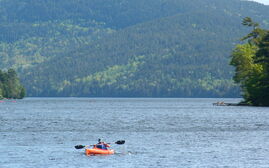UMaine still committed to offshore wind project
The University of Maine and its partners remain committed to the Aqua Ventus 1 offshore wind project, despite coming up short Wednesday in the second round of U.S. Department of Energy’s grants to advance emerging technologies for offshore wind energy.
Asked if the loss of the hoped-for $46.7 million in DOE funding put the Aqua Ventus project at risk of folding, Jake Ward, UMaine's vice president for innovation and economic development, told Mainebiz, “Absolutely not.”
In a press release announcement Wednesday afternoon, the DOE said the Maine project would receive $3 million in R&D funding. Offshore projects in New Jersey, Virginia and Oregon are slated to get $46.7 million grants over the next four years to help them achieve commercial operation by 2017.
UMaine’s project, now called New England Aqua Ventus 1, was selected fourth of the six projects vying for the DOE grants. It will remain an alternate in the DOE’s Advanced Technology Demonstration program should additional funding become available, or if one of the other projects folds.
Ward said the university would use the DOE’s $3 million funding to complete its R&D work on the innovative concrete hull and advanced composite tower utilized in its 1:8 scale floating prototype, VolturnUS, which has been deployed off Castine.
In a conference call that included lawyer Jeffrey Thaler Wednesday afternoon with Mainebiz, Ward said the $3 million awarded by DOE will enable the university and its partners to keep pace with the three other projects in achieving the grant program’s first-year goal of bringing projects to full completion of their design and engineering. He said the Aqua Ventus partnership, which includes Cianbro and Emera Maine, remains committed to the overarching goal of tapping the Gulf of Maine’s winds as a huge source of renewable power for Maine.
“The winds in the Gulf of Maine are still there,” he said. “The need for economical, environmentally sustainable renewable energy that can create local and U.S. jobs is still an important goal for Maine and the United States. The extensive work that the UMaine lead team has completed is very important to meeting those goals.”
In a joint statement Sens. Susan Collins and Angus King also put a hopeful spin on the $3 million R&D award, saying it shows that DOE “clearly recognizes the [Aqua Ventus] project’s enormous potential.”
“DOE is pledging to engage in an R&D partnership and continue its investment in the University’s innovative deep-water, offshore wind technology,” the senators said in their press release. “100% design completion is no mere consolation prize, but rather an extraordinary investment and proof that the DOE knows what we have long known: that the Gulf of Maine is a tremendous resource for wind energy that could provide an affordable source of renewable energy directly to the country’s population centers on the East Coast while creating thousands of new jobs in Maine. In addition, it would diversify Maine’s electricity supply.”
Thaler, who's working for the university on the Aqua Ventus project, told Mainebiz in the conference call that the term sheet approved by the Maine Public Utilities Commission in January is still in place. But Thaler acknowledged the UMaine consortium will be conferring with the PUC about what impact, if any, losing the full $46.7 million in DOE funding might have on the term sheet, a 20-year power contract that had been based on two 6-megawatt wind turbines being installed in the Gulf of Maine near Monhegan Island.
“Our hope is that we will keep that in place,” Thaler said. “We’re still very committed to seeing our technology advance [to commercial scale].”
DOE’s winning projects are:
• Dominion Virginia Power, which plans to install two 6MW direct-drive wind turbines 26 miles off the coast of Virginia Beach. This project was described in a DOE press release as incorporating “hurricane-resilient design features to ensure that offshore wind facilities placed in hurricane-prone waters are reliable, safe and cost-effective.”
• Fishermen’s Energy of New Jersey, which plans to install five 5MW direct-drive wind turbines in state waters about three miles off the coast of Atlantic City, N.J. This project was described by DOE as an opportunity to demonstrate the use of a “twisted jacket foundation that is easier to manufacture and install than traditional foundations, helping drive down the cost of energy produced by the offshore wind system.”
• Principle Power, which plans to install five 6-megawatt direct-drive wind turbines about 18 miles off the coast of Coos Bay, Ore. This project bears the closest similarity to Maine’s Aqua Ventus technology, in that its uses a semi-submersible floating foundation that will be assembled on shore and towed out to sea.
In an April 1 letter sent to DOE Secretary Ernest Moniz, Reps. Chellie Pingree and Mike Michaud joined other members of New England’s congressional delegation in touting UMaine’s innovative prototype VolturnUS.
“The strength and corrosion resistance of concrete and composites make them ideally suited for harsh marine environments,” they wrote. “These components will also be entirely made in America, creating jobs through New England. Further, Aqua Ventus’ proposed concrete hull could be cost effectively reproduced through the country, creating local jobs in any state that develops its offshore wind energy in the future.”
Read more
UMaine consortium lands $3 million R&D grant to continue offshore wind project














Comments